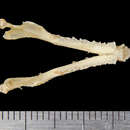Talpa[3] is a genus in the mole family Talpidae. Among the first taxa in science,[4] Carolus Linnaeus used the Latin word for "mole", talpa, in his Regnum Animale to refer to the commonly known European form of mole. The group has since been expanded to include 13 extant species, found primarily in Europe and western Asia. The European mole, found throughout most of Europe, is a member of this genus, as are several species restricted to small ranges. One species, Père David's mole, is data deficient. These moles eat earthworms, insects, and other invertebrates found in the soil.
The females of this genus have rudimentary male features such as Cowper's glands and a two-lobed prostate. A group of scientists has suggested that they are true hermaphrodites;[5] however, others state that they are fully functional females.[6]
There are 13 species in this genus:
-
Altai mole, T. altaica
-
Aquitanian mole, T. aquitania[7]
-
Blind mole, T. caeca
-
Caucasian mole, T. caucasica
-
Père David's mole, T. davidiana
-
European mole, T. europaea
-
Levant mole, T. levantis
-
Martino's mole, T. martinorum
-
Spanish mole, T. occidentalis
-
Ognev's mole, T. ognevi
-
Roman mole, T. romana
-
Balkan mole, T. stankovici
-
Talysch mole, T. talyschensis
In addition, several extinct species are known from fossil remains, including the Tyrrhenian mole (Talpa tyrrhenica) from the Pleistocene of Corsica and Sardinia.[8]
The current phylogeny of the species in the genus is shown below:
Phylogeny of the Eurasian moles according to Demırtaş et al. 2020
[9] Talpa altaica
Talpa ognevi
Talpa caucasica
Talpa talyschensis
Talpa davidiana
Talpa caeca
Talpa stankovici
Talpa levantis
Talpa romana
Talpa martinorum
Talpa occidentalis
Talpa aquitania
Talpa europaea
References
-
^ Benito, C.S.; Martinez, N.L. (1977). "El yacimiento de Escobosa de Calatanyazor (Soria) y su aportacion a la bioestratigraphia del Neogeno de la meseta castellana". In M.T. Alberdi and e. Aguirre (Eds) Round-table on Mastostratigraphy of the W. Mediterranean Neogene Trabajos Sobre Neogeno-Cuaternario. Madrid. 7: 35–40.
-
^ International Commission on Zoological Nomenclature (1922). "Opinion 75. Twenty-Seven Generic Names of Protozoa, Vermes, Pisces, Reptilia and Mammalia Included in the Official List of Zoological Names". Smithsonian Miscellaneous Collections. 73 (1): 35–37.
-
^ Hutterer, R. (2005). "Genus Talpa". In Wilson, D.E.; Reeder, D.M. (eds.). Mammal Species of the World: A Taxonomic and Geographic Reference (3rd ed.). Johns Hopkins University Press. pp. 307–309. ISBN 978-0-8018-8221-0. OCLC 62265494.
-
^ http://upload.wikimedia.org/wikipedia/commons/b/bb/Linnaeus_-_Regnum_Animale_%281735%29.png
-
^ Sánchez, A; Bullejos, M; Burgos, M; Hera, C; Stamatopoulos, C; Diaz De la Guardia R; Jiménez, R (1998-12-07). "Females of four mole species of genus Talpa (Insectivora, mammalia) are true hermaphrodites with ovotestes". Molecular Reproduction and Development. 44 (3): 289–294. doi:10.1002/(SICI)1098-2795(199607)44:3<289::AID-MRD2>3.0.CO;2-I. PMID 8858598.
-
^ Beolchini, F; Rebecchi, L; Capanna, E; Bertolani, R (2000-06-01). "Female gonad of moles, genus Talpa (Insectivora, mammalia): ovary or ovotestis?". J Exp Zool. 286 (1): 745–54. doi:10.1002/(SICI)1097-010X(20000601)286:7<745::AID-JEZ9>3.0.CO;2-F. PMID 10797327.
-
^ Nicolas, Violaine; Martínez-Vargas, Jessica; Hugot, Jean-Pierre (2017). "Talpa aquitania sp. nov. (Talpidae, Soricomorpha), a new mole species from SW France and N Spain" (PDF). Mammalia. 81 (6): 641–642. doi:10.1515/MAMMALIA-2017-0057. S2CID 90926022.
-
^ Bate, Dorothea M.A. (1945). "XLII. — The pleistocene mole of Sardinia". Annals and Magazine of Natural History. Series 11. 12 (91): 448–461. doi:10.1080/00222934508654743.
-
^ Sadık Demırtaş, Metin Silsüpür, Jeremy B. Searle, David Bilton und İslam Gündüz: What should we call the Levant mole? Unravelling the systematics and demography of Talpa levantis Thomas, 1906 sensu lato (Mammalia: Talpidae). Mammalian Biology 100, 2020, S. 1–18, doi:10.1007/s42991-020-00010-4


